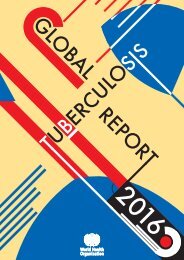patients
DNDi_AR_2015
DNDi_AR_2015
Create successful ePaper yourself
Turn your PDF publications into a flip-book with our unique Google optimized e-Paper software.
FILARIAL DISEASES<br />
R&D MODEL & PORTFOLIO<br />
TRANSLATION<br />
Macrofilaricide 2<br />
PROJECT START: March 2015<br />
OVERALL OBJECTIVE: Develop a macrofilaricide effective<br />
against worm-symbiotic Wolbachia bacteria<br />
Two derivatives of a veterinary antibiotic, which target<br />
the worm-symbiont Wolbachia bacterium, are currently<br />
in development for treatment of filarial diseases. These<br />
compounds can be delivered orally, induce a robust anti-<br />
Wolbachia effect in several in vivo models, demonstrate clear<br />
superiority over doxycycline, and are effective after a shorter<br />
dosing regimen. Preliminary safety and toxicology profiling of<br />
these compounds carried out in 2015 suggests a favourable<br />
safety profile. Upon successful completion of the necessary<br />
toxicology studies, expected in 2016, and development of an<br />
oral formulation, a Phase I single rising dose study in healthy<br />
human volunteers will be performed to determine the safety,<br />
tolerability, maximum tolerated dose, and pharmacokinetics<br />
of single oral doses of the selected compound. If appropriate<br />
pharmacokinetic characteristics are demonstrated and are<br />
suggestive of sufficient therapeutic margins, the safety,<br />
tolerability, and pharmacokinetics of multiple ascending<br />
doses of an oral formulation of the compound will be<br />
determined. To demonstrate proof of concept for filarial<br />
disease, a Phase Ib programme will be conducted in <strong>patients</strong>.<br />
This programme will be designed to provide data on which<br />
a collective decision can be made to proceed into Phase II<br />
studies in <strong>patients</strong> with either onchocerciasis or lymphatic<br />
filariasis.<br />
MAIN PARTNERS: AbbVie, USA; Liverpool School of Tropical<br />
Medicine, UK<br />
Emodepside<br />
PROJECT START: March 2013<br />
OVERALL OBJECTIVE: Develop emodepside as a new<br />
macrofilaricidal treatment for <strong>patients</strong> suffering from<br />
onchocerciasis<br />
2015 OBJECTIVES:<br />
• Complete pre-clinical package for first-in-human study<br />
• Progress emodepside into first-in-human study<br />
Emodepside is a semi-synthetic product (originated by<br />
Astellas and out-licensed to Bayer for animal and human<br />
use); its precursor is synthesized by a fungus living in the<br />
leaves of Camellia japonica. It is a potent antihelminthic drug<br />
used in combination with praziquantel (as Profender ® ) and in<br />
combination with toltrazuril (as Procox ® ) for the treatment of<br />
parasitic worms in cats and dogs. DNDi and Bayer Pharma<br />
AG are jointly developing emodepside for the treatment of<br />
onchocerciasis <strong>patients</strong>. DNDi will be responsible for the<br />
pre-clinical and clinical development of emodepside and<br />
Bayer for the pharmaceutical development, manufacturing,<br />
registration, and supply of the drug at the lowest sustainable<br />
price. The pre-clinical package to start Phase I studies was<br />
completed and recruitment into a single-ascending dose<br />
study was initiated in December 2015.<br />
MAIN PARTNER: Bayer HealthCare, Germany<br />
Filling knowledge gaps<br />
As is frequently the case with neglected diseases, there are<br />
a number of knowledge gaps. DNDi partners are carrying out<br />
modelling studies aiming to quantify and characterize the<br />
future needs of <strong>patients</strong> suffering from onchocerciasis and<br />
lymphatic filariasis, and to provide information on the size<br />
and profile of target populations for the new treatments in<br />
development. There is also a need for reliable biomarkers<br />
of disease evolution which can assess the effect of new<br />
treatments as an alternative to existing invasive skin biopsies<br />
and nodulectomies. A new medical optical imaging technique<br />
is being evaluated, which aims to find an optical signature of<br />
live versus dead O. volvulus worms in subcutaneous nodules.<br />
PARTNERS: Erasmus University, the Netherlands; CEA-LETI (1),<br />
France; REFODTE, Cameroon; Institut de Recherche pour le<br />
Développement, France.<br />
(1) LETI a French state-owned research entity, (Commissariat à<br />
l’énergie atomique et aux énergies alternatives (CEA), Laboratoire<br />
d’Électronique et de Technologies de l’Information (LETI).<br />
DNDi Annual Report 2015 › 43



